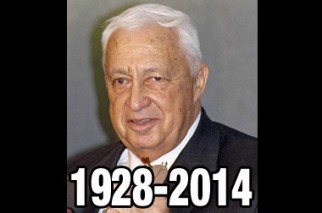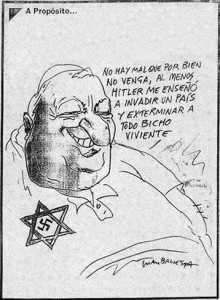January 12, 2014 15:05
by Simon Plosker

Throughout the years, and particularly since his 2001 election as prime minister, the international media has treated Ariel Sharon with more vitriol and abuse than any other democratically elected leader in the civilized world. Sharon has been depicted in less than flattering terms by many media outlets who have labeled him as a “war criminal” and a “butcherer,” a trend we are once again seeing in today’s media coverage.
Media analyst Tom Gross contends:

A week earlier, El Pais, Spain’s equivalent of The New York Times, published a cartoon of an allegorical figure carrying a small rectangular-shaped black moustache, flying through the air towards Sharon’s upper lip. The caption read: “Clio, the muse of history, puts Hitler’s moustache on Ariel Sharon”.
Cartoons in the Greek press in 2004 showed Sharon as a Nazi officer. One of Italy’s leading papers, Corriere Della Sera, ran a cartoon on March 31, 2002, showing Sharon killing Jesus. (The cartoon, which was timed to coincide with Easter that year, was published as Israelis lay dying from the Netanya Passover massacre three days earlier.)
Hundreds of similar anti-Semitic motifs have been applied to Sharon in recent years. The Economist magazine in London compared him to Charles Dickens’s infamous anti-Semitic stereotype, Fagin.
In today’s obituaries, there are three common examples of bias where missing context or incorrect information are being employed to present Sharon as a “butcher” or “war criminal”:
Sabra and Shatila
A charge commonly leveled at Sharon is that he is responsible for the massacre of thousands of Palestinians in the Sabra and Shatila refugee camps during the 1982 Lebanon War.
Headline: Daily Mail
In fact, as detailed by Mitchell Bard’s Myths Facts, the killings were carried out by the Lebanese Christian Phalangist militia (whose members have still not been held accountable). Israel’s own Kahan Commission found that Israel and Ariel Sharon were indirectly responsible for not anticipating the possibility of Phalangist violence. Sharon thus resigned his position as Defense Minister.
Myths and Facts states:
The Lebanese Christian Phalangist militia was responsible for the massacres that occurred at the two Beirut-area refugee camps on September 16–17, 1982. Israeli troops allowed the Phalangists to enter Sabra and Shatila to root out terrorist cells believed to be located there. It had been estimated that there may have been up to 200 armed men in the camps working out of the countless bunkers built by the PLO over the years, and stocked with generous reserves of ammunition.
When Israeli soldiers ordered the Phalangists out, they found hundreds dead (estimates range from 460 according to the Lebanese police, to 700–800 calculated by Israeli intelligence). The dead, according to the Lebanese account, included 35 women and children. The rest were men: Palestinians, Lebanese, Pakistanis, Iranians, Syrians and Algerians. The killings were perpetrated to avenge the murders of Lebanese President Bashir Gemayel and 25 of his followers, killed in a bomb attack earlier that week.
Israel had allowed the Phalange to enter the camps as part of a plan to transfer authority to the Lebanese, and accepted responsibility for that decision. The Kahan Commission of Inquiry, formed by the Israeli government in response to public outrage and grief, found that Israel was indirectly responsible for not anticipating the possibility of Phalangist violence. Subsequently, Defense Minister Ariel Sharon resigned and the Army Chief of Staff, Gen. Raful Eitan, was dismissed.
In 1985 an American jury decided that Sharon had been defamed by Time Magazine, which had inferred that Sharon either ”consciously intended” or ”actively encouraged” the killing of the civilians.
The Outbreak of the Second Intifada
One of the most pervasive myths appearing in the international media is the accusation that Ariel Sharon’s September 2000 visit to the Temple Mount was responsible for the outbreak of Palestinian violence against Israel.
AFP:
Sharon made a provocative visit to the flashpoint Al-Aqsa mosque compound in Jerusalem’s Old City, sparking the outbreak of the second Palestinian intifada.
Palestinians contend that the now-momentous September 2000 Sharon visit to the site – where according to Muslim traditions Prophet Mohammed ascended to heaven, and where King Solomon initially built the Temple that had become Judaism’s holiest site – launched the intifada.
But, do Palestinians really contend that Sharon’s visit launched the intifada?
Palestinian Communications Minister Imad Al-Faluji, Al-Safir, 3 March 2001. (Translated by MEMRI):
Whoever thinks that the Intifada broke out because of the despised Sharon’s visit to the Al-Aqsa Mosque is wrong.. . . This Intifada was planned in advance, ever since President Arafat’s return from the Camp David negotiations, where he turned the table upside down on President Clinton.
Yasser Arafat’s wife Suha said the following (from Palestinian Media Watch):
On the personal level, I miss him very, very much. [Our daughter] Zahwa also misses him, you can’t imagine. She didn’t know him. She knows that Arafat sent us away before the [Israeli] invasion of Ramallah. He said: ‘You have to leave Palestine, because I want to carry out an Intifada, and I’m not prepared to shield myself behind my wife and little girl.’ Everyone said: ‘Suha abandoned him,’ but I didn’t abandon him. He ordered me to leave him because he had already decided to carry out an Intifada after the Oslo Accords and after the failure of Camp David [July 2000].
Imad Faluji, PA Minister of Communications:
Whoever thinks that the Intifada started because of the hated Sharon’s visit to Al-Aqsa Mosque is mistaken. That was only the straw breaking the Palestinian people’s patience. This Intifada was already planned since [Arafat] the President returned from the recent talks at Camp David [July 2000].” [Private filming of speech by Faluji, Dec. 5, 2000]
The Israel Project notes that American diplomat Dennis Ross recounts in his book The Missing Peace how the Israelis called Washington with proof that the Palestinians were “planning massive, violent demonstrations throughout the West Bank and the next morning, ostensibly a response to the Sharon visit.” Washington pressured Arafat to dampen the violence, but the Palestinian leader – again per Ross – “did not lift a finger to stop the demonstrations, which produced the second Intifada.”
In addition, the Mitchell Report submitted by the investigatory committee set up to look into the causes of the outbreak of violence concluded:
The Sharon visit did not cause the Al-Aqsa Intifada.
See more quotes from senior Palestinians and media admitting responsibility for the Second Intifada at Palestinian Media Watch.
At least Time Magazine gets it right:
While some Israelis and Palestinians blamed Sharon for provoking the violence, it soon became clear that Arafat, who fanned the unrest, had been spoiling for a fight and would have taken any excuse.

In 1953 he [Sharon] helped form Unit 101, a unit that carried out reprisals for the slaying of an Israeli woman and her two children. His troops blew up more than 40 houses in Qibya, a West Bank village then ruled by Jordan, slaughtering 69 Arabs. Sharon later said he thought the houses were empty.
Sharon is often accused of responsibility for the deaths of 69 Jordanian civilians in a raid on the village of Qibya. The 1953 Qibya raid was part of an Israeli government policy to respond to deadly terrorist raids by “fedayeen” terrorists sponsored by neighboring Jordan and Egypt. Hundreds of Israeli civilians had been killed, and the government responded by sending Sharon’s 101 Unit to hit the fedayeen, the army bases that supported them, and the villages that housed them. As the force approached the village, hundreds of Qibya residents were seen fleeing. The force believed that all residents had fled.
According to the official IDF Encyclopedia, the soldiers found a young girl in one house and an elderly man in another. They were quickly chased away. Soon after, IDF sappers blew up dozens of Qibya houses. No one knew that 69 civilians were hiding inside the homes. Their deaths were not deliberate but the result of faulty intelligence and the military operation was widely condemned, both within Israel and outside.
Reuters states:
Wounded as a young officer in the 1948 war of Israel’s founding, he [Sharon] went on to lead key commando units and crafted a policy of reprisals – even at the cost of innocent lives – for cross-border Palestinian guerrilla raids.
A “policy of reprisals – even at the cost of innocent lives” falsely implies that it was actually Israeli policy to target innocent civilians. This has never been the policy of the IDF, which goes to incredible lengths to avoid civilian casualties.
Other Bias
That Palestinians and other Arab commentators are giving negative comments to the media is unsurprising given Sharon’s reputation and image in the Arab world and it is legitimate to report on these sentiments. But what about so-called experts who are pushing a personal agenda rather than giving objective analysis?
NPR quotes Mark LeVine, professor of contemporary Middle East history at the University of California, Irvine:
Sharon’s actions as both a soldier and a politician reflected the innermost fears and desires of many Israelis about the nation they longed to establish in what was essentially a hostile environment, LeVine said.
“They knew that in order for Israel to succeed and for Zionism to succeed, it involved necessarily a conflict with the indigenous population of the country that was never going to be neat or pleasant,” LeVine said.
That LeVine presents Israel as a colonialist outsider conflicting with an “indigenous population” is hardly surprising considering that he is a prominent supporter of the Boycott, Divestment and Sanctions (BDS) movement.

It’s a shame that Sharon has gone to his grave without facing justice for his role in Sabra and Chatilla and other abuses.
Human Rights Watch has been exposed time and again as displaying a clear anti-Israel obsession and Sarah Leah Whitson has a long history of anti-Israel activism, including support for BDS. As NGO Monitor notes, in May 2009, Whitson led a trip to seek support in Saudi Arabia, where she emphasized HRW’s “shortage of funds because of the global financial crisis and the work on Israel and Gaza, which depleted HRW’s budget for the region.” She highlighted HRW’s stance of standing up to “pro-Israel pressure groups,” which, she declared, “strongly resisted the report and tried to discredit it.”
That HRW and Sarah Leah Whitson are quoted as credible sources is a testament to the unhealthy symbiotic relationship between the media and NGOs and the “halo effect” that gives rise to so-called human rights organizations being considered beyond reproach.
Keep an eye on your local media to assess the coverage of Ariel Sharon’s life and death. Is it fair or has Sharon’s record been decontextualized to create an unfair or inaccurate portrayal?










